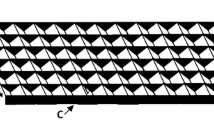Abstract
-
1.
For X-ray small angle research usually a primary beam of line shaped crosssection is applied. The longest known is the three-slit-camera with two parallel diaphragms defining the primary beam and the third one limiting the parasitic scattering caused by the second one.
-
2.
The difficulty of the correct mutual adjustment of the three diaphragms is circumvented by the block collimation system, where the primary beam is guided by three bodies (2 blocks and 1 edge). The essential principle is the exact coincidence of the extremely smooth upper surface of the first block (middle block) with the also perfectly plane bottom surface of the second block (bridge) in their mutual extension. The third diaphragm, the edge, controls the widths of the ribbon-shaped primary beam and is situated as entrance slit in front of the two blocks, this being closest to the X-ray tube.
-
3.
The basic concept from 1954 has been maintained, however, the entire apparatus of the small angle camera has been modified. Only the earliest professional type, the building block camera, has been described in a comprehensive communication (1958); the more recently developed types are only known from short communications and from prospects of the manufacturer, A. Paar KG. The main topic of the present work is the description of the most important recent type, the compact camera. Whereas the individual parts of the building block camera are mounted on some kind of optical rail in a mutually adjustable way, all parts of the compact camera except the detector slit and the detector are accomodated in an evacuated compact rigid housing without foils or air paths to be penetrated like for the building block camera. An important feature is the support of the front end of the camera on top of the X-ray tube avoiding those minor movements between camera and X-ray tube caused by thermal and mechanical influences. As shown by experiment, practically perfect stability of the scattering intensity at medium and high resolution (above 1000 Å) is obtained by these means. Moreover, the independent motion of detector slit and detector shall be mentioned, as well as the improved coincidence of surfaces of the beam — guiding blocks, operation of the vacuum surrounded entrance slit from outside etc.
-
4.
An attempt of an optimization is made with view to obtain maximum primary intensity at a given resolution, measured by the smallest angle from which on a scattering measurement is possible. This optimization was tried to be achieved by variation of two experimental parameters: Variation of the pick-up angle of the radiation from the focus and the position of the middle-block of the collimation system which is in between the entrance slit and the bridge. The primary energy entering the collimation system in dependence of the two variables has been calculated
-
a)
under the assumption of an ideal focus (no tungsten deposition, perfectly plane, pure surface emission),
-
b)
with consideration of the experimentally determined attenuation of the primary beam by deviations from an ideal focus.
-
5.
Intensity gains by more than a factor of 2 compared with the conventional method can be achieved in the case of high resolution (corresponding to smallest measuring angles which compare to Bragg's values in the range of 1300 to 2000 Å depending on the degree of imperfections of the collimation system) and a rather new X-ray tube by a certain combination of pick-up angle and position of the middle block.
-
6.
Finally, the problem of resolution is discussed on a mathematical basis. In addition, a prototype calles “integrated camera”, with the X-ray tube built into and thus integrated into an elongation part of the camera in a adjustable way, is described. This instrument is especially designed for extremely high resolution (some thousand Angstroms) since even smallest relative movements of X-ray tube and collimation system are completely suppressed.
Similar content being viewed by others

References
Glatter O, Kratky O (eds) (1982) Small Angle X-ray Scattering, Academic Press London
Guinier A, Fournet G (1955) Small Angle Scattering of X-rays, Wiley, New York, and Chapman and Hall, London 86 pp
Bolduan OEA, Bear RS (1949) J Appl Phys 20:283
Ritland HN, Kaesberg P, Beeman W (1950) J Appl Phys 21:838
Anderegg JW, Beeman WW, Shulman S, Kaesberg, PJ (1955) J Amer Chem Soc 77:2927
Kratky O (1954) Z Elektrochem 58:49, (1958) 62:66
Kratky O, Skala Z, (1958) Z Elektrochem 62:73
Stabinger H, Kratky O (1979) Makromol Chem 180:2995
Kratky O, Leopold H (1964) Makrom Chem 75:69
Hendricks RW (1970) J Appl Cryst 3:348
Leopold H (1968) Z angew Phys 25:81, (1969) English translation in Siemens Review 36:51
Kratky O, Leopold H (1970) Makrom Chem 133:151
Author information
Authors and Affiliations
Additional information
Dedicated to Professor J. Schurz with congratulations for his 60th birthday.
Rights and permissions
About this article
Cite this article
Kratky, O., Stabinger, H. X-ray small angle camera with block-collimation system an instrument of colloid research. Colloid & Polymer Sci 262, 345–360 (1984). https://doi.org/10.1007/BF01410252
Received:
Accepted:
Issue Date:
DOI: https://doi.org/10.1007/BF01410252


